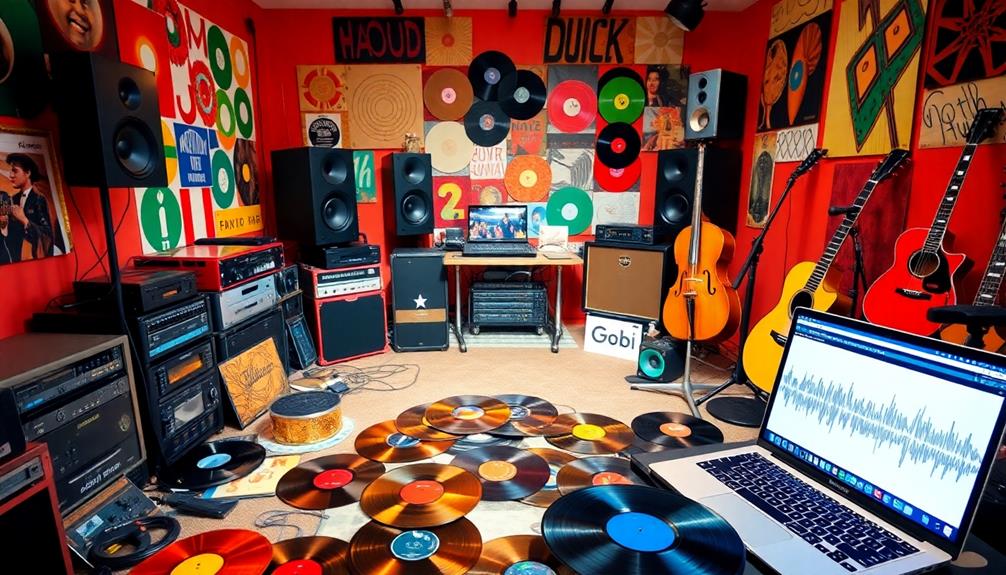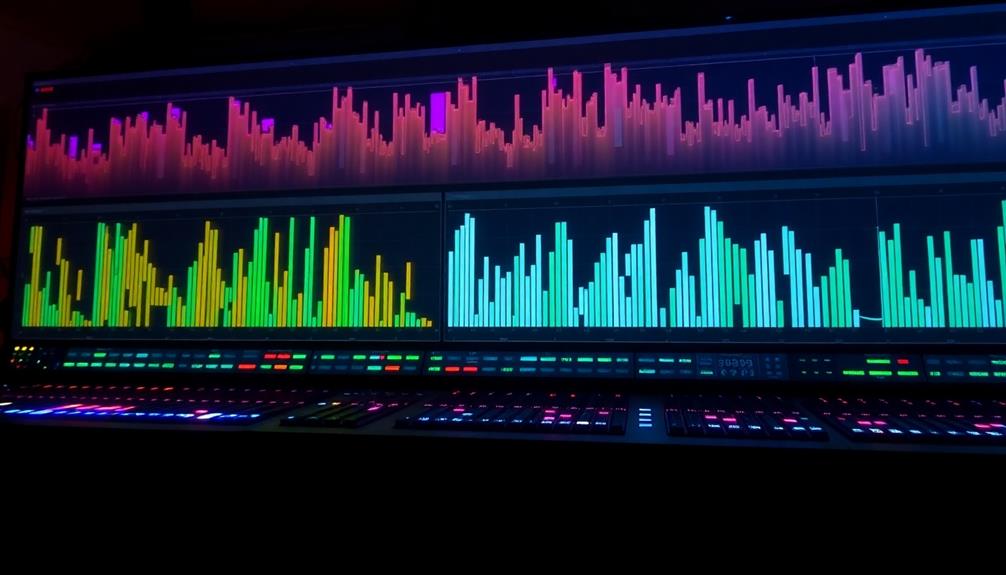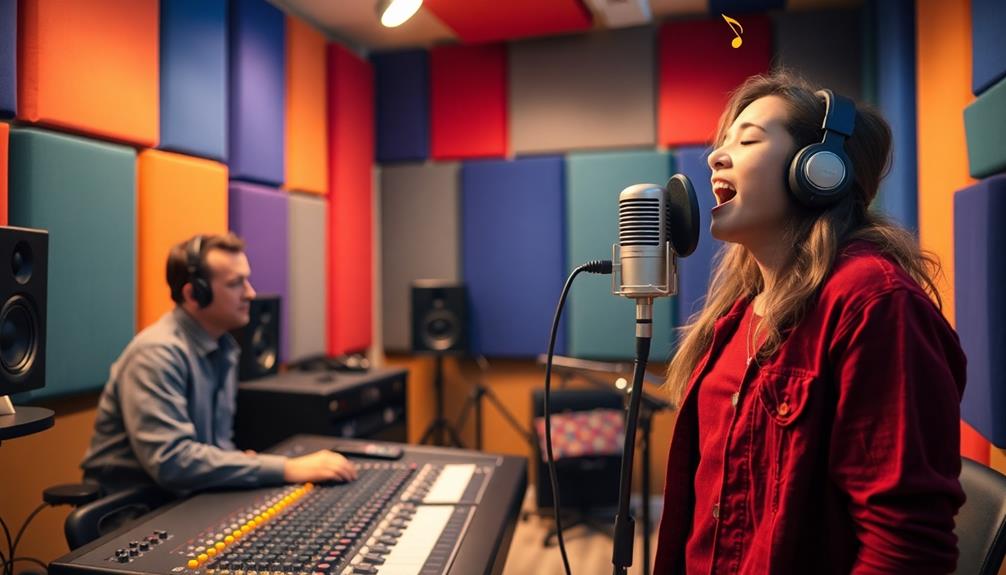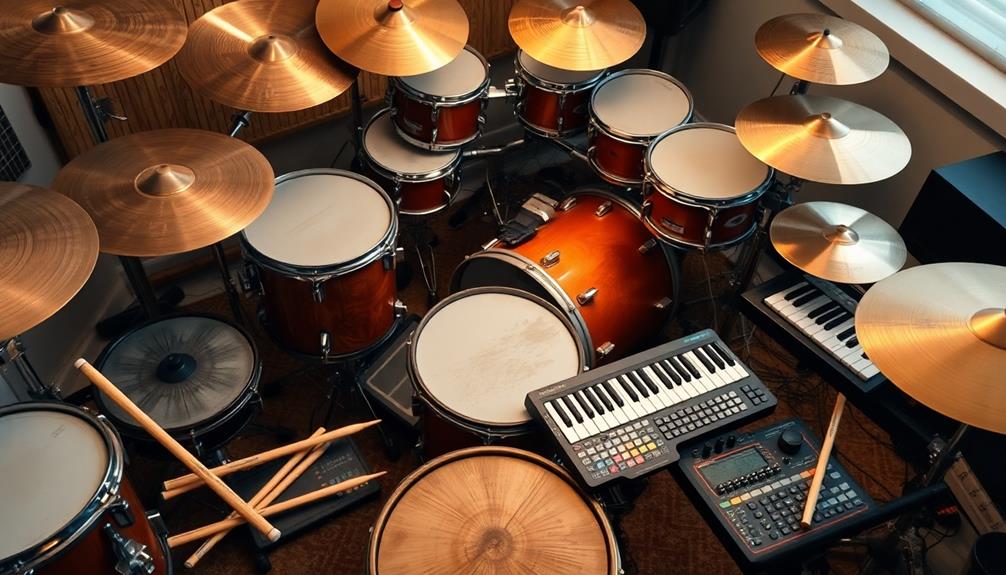To develop a unique sound as a producer, start by mastering the basics of music production. Familiarize yourself with essential software and tools, then experiment with unconventional instruments and layers. Find your voice by expressing your emotions and drawing inspiration from your favorite artists. Consistency is key; set regular production goals and seek feedback to refine your craft. Embrace collaboration and continuously learn from others in the community. Remember, patience and practice will help shape your distinct style over time. Stick around to discover more tips for enhancing your production journey and making your sound truly stand out.
Key Takeaways
- Experiment with unconventional sounds and instruments to create unique textures that set your music apart from others.
- Regularly practice producing new tracks to refine your skills and discover your distinctive musical voice.
- Collaborate with other artists to gain new perspectives and influence your sound development through shared creativity.
- Draw inspiration from various genres and cultures to infuse your music with unique elements and broaden its appeal.
- Establish a consistent brand identity through cohesive visuals and regular engagement on social media to enhance recognition.
Learn the Basics

Mastering the fundamentals of music production is essential for developing your unique sound. Start by familiarizing yourself with essential software like Ableton Live or FL Studio. These tools are vital for creating and manipulating audio. You should also invest time in learning about hardware tools, such as MIDI controllers and audio interfaces, which enhance your production capabilities.
Additionally, understanding how to use music production software effectively can greatly influence your creative process.
Next, gain a solid understanding of recording techniques. Practice capturing vocals and instruments properly, as this will greatly impact the quality of your tracks.
Don't overlook the editing process; mastering it will help you refine your sound and find your voice as a producer.
Incorporate music theory into your work. Understanding chord progressions and song structure can elevate your compositions and make them more engaging.
Explore various genres and styles, from electronic to acoustic, to broaden your production techniques. This exploration can inspire creativity in your work and help you carve out your unique sound.
Experiment With Sounds

To develop your unique sound, start by utilizing unconventional sound sources, like everyday objects or field recordings.
Layer those sounds in unexpected ways to create original textures that captivate your audience.
Utilize Unique Sound Sources
Experimenting with unique sound sources can greatly elevate your productions and set you apart as a producer. By stepping outside the typical samples and synths, you can create a signature sound that truly resonates.
Here are some effective strategies to help you sound different:
- Utilize field recording techniques: Capture unique sounds from everyday environments, like bustling streets or serene nature, to add authenticity to your tracks. Incorporating diverse soundscapes can enhance the emotional depth of your music, creating an immersive experience similar to the role of contrast ratio in projector image quality.
- Incorporate unconventional instruments: Use objects around you—kitchen utensils, stones, or even your voice—to create interesting textures that enhance your music.
- Manipulate ordinary sounds: Experiment with audio manipulation tools like granular synthesis or pitch shifting. Transform simple recordings into innovative musical elements that surprise your listeners.
- Explore diverse tempos and scales: Don't hesitate to play with different rhythmic patterns and harmonic progressions. This keeps your sound fresh and enthralling.
Layering Techniques for Originality
There's something enchanting about the art of layering sounds that can transform an ordinary track into an extraordinary one. By combining multiple audio tracks with varying frequencies, timbres, and dynamics, you can create a richer sonic texture that enhances your composition's impact.
To develop your unique voice, immerse yourself in experimenting with sounds from different genres. Use organic recordings, synthesized sounds, and unique samples to form layers that contribute to your original sound signature. Understanding production quantity variance can also help you manage the resources effectively while experimenting.
Don't shy away from using effects like reverb, delay, and modulation on individual layers; these can add depth and movement, helping each element shine while maintaining cohesion. Adjusting the volume, panning, and EQ of each layer allows you precise control over the mix, ensuring clarity for every component in your production.
Regularly experiment with unconventional layering techniques—like inverse filtering or creative automation—to achieve unexpected results. This approach can lead to distinctive soundscapes that set you apart from other producers.
Find Your Voice

Finding your voice as a producer is like uncovering a hidden gem; it requires introspection and creativity. Your unique sound emerges from a blend of personal experiences, influences, and experimentation.
To help you on this journey, consider the following steps:
- Express Yourself: Channel your emotions and life experiences into your music. This authenticity resonates deeply, creating a strong connection with your audience.
- Draw Inspiration: Incorporate elements from artists you admire. This can help shape your artistic vision while ensuring your compositions maintain originality.
- Utilize Personal Instruments: Use instruments or sounds that hold personal significance. This enhances the emotional depth of your music, making it distinctly yours.
- Embrace Cultural References: Infuse your work with cultural elements that reflect your identity and heritage. This enriches your musical expression and broadens your appeal.
Regularly experimenting with different styles and techniques will reveal what truly resonates with you.
Develop Your Skills
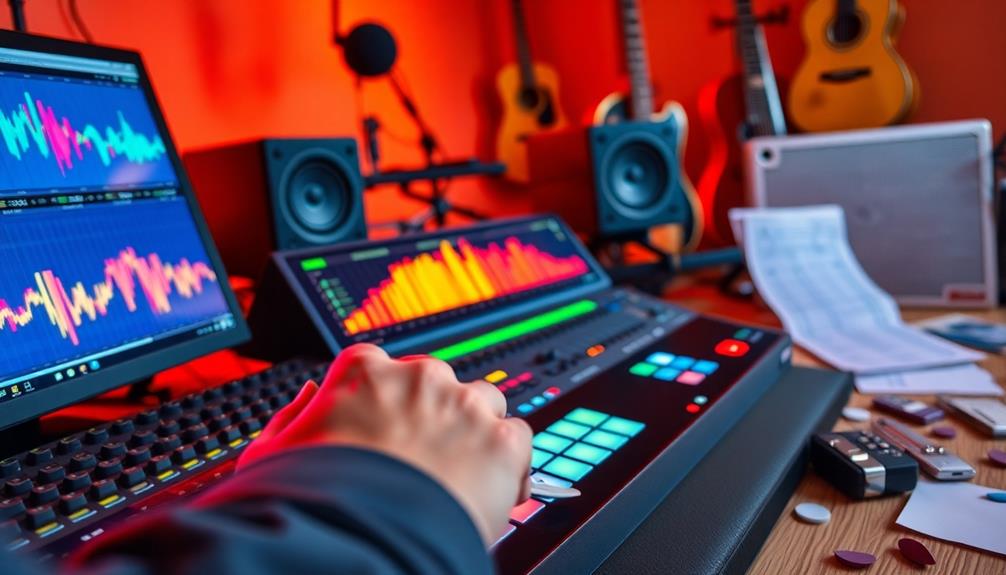
To develop your skills as a producer, make regular practice a priority by creating beats or remixes consistently.
Collaborating with other artists can also open up new perspectives and techniques that enhance your craft.
Set clear goals for your projects to keep pushing your creative boundaries and refining your unique sound.
Regular Practice Techniques
Consistent practice is essential for honing your skills as a music producer. By setting aside dedicated time for regular practice, you'll foster creativity and develop a unique sound.
Here are four techniques to help you maximize your practice sessions:
- Create Regularly: Challenge yourself to produce at least one new beat, remix, or original song each week. This keeps your creativity flowing and helps you explore different musical ideas.
- Seek Feedback: Utilize online platforms and communities to share your work and receive constructive feedback. This insight is invaluable for your growth as a producer.
- Invest in Learning: Consider enrolling in music production courses or tutorials that focus on specific techniques or software. Expanding your knowledge will refine your skill set and enhance your productions.
- Analyze Favorites: Regularly analyze and recreate tracks from your favorite producers. Understanding their techniques will help you incorporate diverse styles and find your sound.
Collaborative Learning Opportunities
Collaborative learning opportunities can greatly enhance your skills as a music producer. By collaborating with other producers, you expose yourself to different techniques and perspectives, which can inspire innovation in your work.
Join online communities or forums dedicated to music production where you can share feedback, resources, and experiences. This fosters a collaborative learning environment that's vital for your growth.
Participating in local or virtual workshops gives you hands-on experience and direct mentorship from industry professionals. This can accelerate your development considerably.
You might also consider engaging in co-writing sessions with artists. This collaboration can lead to unique sound explorations and help you refine your compositional techniques through shared creativity.
Utilizing platforms like Splice or Kompoz allows you to collaborate with musicians worldwide. These connections can introduce diverse influences, helping you create a sound that stands out.
You'll also get the chance to learn how to use various sample packs, enhancing your production toolkit. Ultimately, these collaborative efforts can provide you with fresh insights and skills, paving the way for your unique sound as a producer.
Embrace these opportunities; they're essential for your growth.
Be Consistent

Establishing a reliable routine can be a game-changer for music producers. When you prioritize consistency in output, you're laying down the essential building blocks for your unique sound and style of music.
Here's how you can enhance your creative process:
- Set a Monthly Goal: Aim to produce a specific number of tracks each month. This creates a rhythm and pushes you to refine your sound.
- Develop Your Brand: Create a memorable name, logo, and visual style. This cohesive image resonates with audiences and fosters recognition.
- Engage on Social Media: Regularly share your music and personal stories. This helps in building a loyal supporter base who'll follow your journey.
- Collaborate and Connect: Engage with the music community through collaborations and feedback. This not only enhances your skills but also maintains your presence in the industry.
Importance of Unique Sound

Creating a unique sound is essential for standing out in today's crowded music landscape. In a saturated market, your distinctive style sets you apart and enhances your brand identity.
When fans recognize your unique sound, they're more likely to develop loyalty and stick around as part of your dedicated audience base.
Just look at artists like Skrillex and Deadmau5; their signature sounds haven't only made them household names but have also demonstrated the marketability of a distinctive style across various genres.
Remix Opportunities

While you may think of remixing as simply reworking someone else's track, it can actually be a powerful avenue for showcasing your unique sound.
By honing your distinctiveness, you open doors to numerous remix opportunities that can elevate your career. Here's how to leverage remixes effectively:
- Attract Contracts: A unique sound can attract remix contracts from labels and artists enthusiastic to incorporate your distinct style into their projects.
- Gain Recognition: Producers known for their distinctive sound often receive more recognition, leading to increased remix offers from established artists.
- Expand Audience: High-profile remixes can greatly expand your audience reach, helping you connect with new listeners who appreciate your unique take on popular tracks.
- Build a Fanbase: Cultivating a unique sound not only increases your chances of remix offers but also fosters a loyal fanbase excited to hear your interpretations.
Patience and Growth

In the journey of developing your unique sound as a producer, patience is key. It's vital to understand that creating something truly original takes time. You'll often need years of dedicated practice and experimentation with various techniques and genres before you find your niche.
Focus on mastering the basics of music production first—recording, mixing, and editing. This solid foundation is critical for producing high-quality work that resonates with listeners.
As you grow, allow yourself the freedom to explore new sounds. Embrace the creative process without the pressure of immediate success. When you're patient, you give yourself the opportunity for organic growth, which can lead to a more authentic musical identity.
Don't rush; instead, enjoy the journey. As you experiment and refine your skills, your sound preferences will evolve naturally.
Continuous Learning and Networking

To develop your unique sound as a producer, continuously learning and networking are vital. Embrace new things that can elevate your skills and expand your connections. Here are four effective strategies to enhance your growth:
- Take Online Courses: Platforms like Coursera and Skillshare offer specialized classes from industry professionals. Immerse yourself in these resources to sharpen your production techniques.
- Attend Local Events: Networking with fellow producers and artists can lead to valuable feedback and collaboration opportunities. These interactions can foster innovation in your voice as a producer.
- Follow Influential Blogs and Channels: Stay updated on the latest tools and trends by engaging with music production blogs like Produce Like A Pro and ADSR. Their insights can inspire you to explore new methods.
- Join Social Media Groups: Being a part of dedicated music production communities allows you to share experiences and gather advice. This supportive environment is essential for continuous learning.
Incorporating these strategies won't only enhance your skills but also create pathways for new opportunities.
Frequently Asked Questions
How to Create Your Own Sound as a Music Producer?
To create your own sound as a music producer, experiment with unique samples, craft custom synth patches, analyze your favorite tracks, produce consistently, and collaborate with others for fresh perspectives. Embrace the journey of discovery!
What Makes a Sound Unique?
A sound's uniqueness springs from its quirky melodies, unexpected rhythms, and wild production techniques. When you blend genres, experiment with rare instruments, and craft original samples, your sonic identity becomes an unforgettable masterpiece that truly stands out!
What Is a Unique Sound Called?
A unique sound is often called a "signature sound." It reflects your distinct style, combining specific elements that resonate with listeners, making your music instantly recognizable and setting you apart from others in the industry.
How Do You Find Unique Sounds?
You wander through familiar spaces, recording everyday sounds, feeling excitement build. You immerse yourself in synth design, analyze tracks that inspire you, and collaborate with others. Each step reveals unique textures, waiting to be discovered.
Conclusion
In your journey to develop a distinctive sound, don't rush the process. Patience pays off as you polish your productions. Keep experimenting, exploring, and expanding your expertise. By fostering friendships within the music community, you'll find fresh inspiration and opportunities. Remember, a unique sound isn't just a goal; it's a gift you give to the world. Stay dedicated, stay curious, and let your creativity shine through every track you create. Your sonic signature is waiting to emerge!

